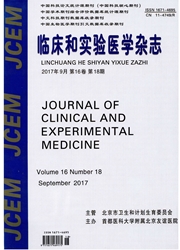

 中文摘要:
中文摘要:
目的探讨后腹腔镜与开放性肾癌根治术治疗局限性肾癌的疗效比较与选择。方法收集2011年1月至2013年1月收治的早期局限性肾癌患者86例,采用前瞻性研究方法,分为观察组和对照组,观察组(43例)采用后腹腔镜肾癌根治性切除术,对照组(43例)采用开放性肾癌根治性切除术,对两组患者围手术期相关指标及术后并发症的发生率进行比较。结果观察组和对照组围手术期手术时间、手术出血量、肠功能恢复时间、术后下床时间、住院天数、住院费用及术后3 d相关实验室检查指标进行比较,除肾功能外,差异有统计学意义(P〈0.05)。观察组术后并发症的总的发生率为9.30%(4/43),对照组为25.58%(11/43),差异有统计学意义(P〈0.05)。结论后腹腔镜肾癌根治术治疗局限性肾癌具有微创、安全、并发症少、对机体炎性反应轻等特点,是今后发展的方向。
 英文摘要:
英文摘要:
Objective To explore curative effect comparison and choice on localized renal cancer radical treatment by Laparoscopic and open surgery.Methods Eighty six patients with localized renal cancer were collected from January 2011 to January 2013.The prospective analysis method was used in this study.All these patients were divided into observation group and control group.The observation group included 43 cases,who received laparoscopic kidney cancer after radical resection.The control group included 43 cases,who received open radical resection of renal cell carcinoma.Related indicators of perioperative patients and the incidence of postoperative complications were compared and analyzed.Results The operation time,surgical perioperative blood loss,bowel function recovery time,postoperative bed time,postoperative hospitalization days,hospitalization expenses and related laboratory examination indexes of observation group and control group were compared and analyzed for total three days.In addition to the renal function,the difference of other indexes was statistically significant(P〈0.05).The incidence of postoperative complications of experimental group was 9.30%(4 /43),while that of the control group was 25.58%(11 /43).The difference of the group was statistically significant(P〈0.05).Conclusion Radical laparoscopic treatment of local kidney cancer is minimally invasive,safe,with less complications and no obvious body inflammatory response,and so on.This method would have good development in the future.
 同期刊论文项目
同期刊论文项目
 同项目期刊论文
同项目期刊论文
 期刊信息
期刊信息
